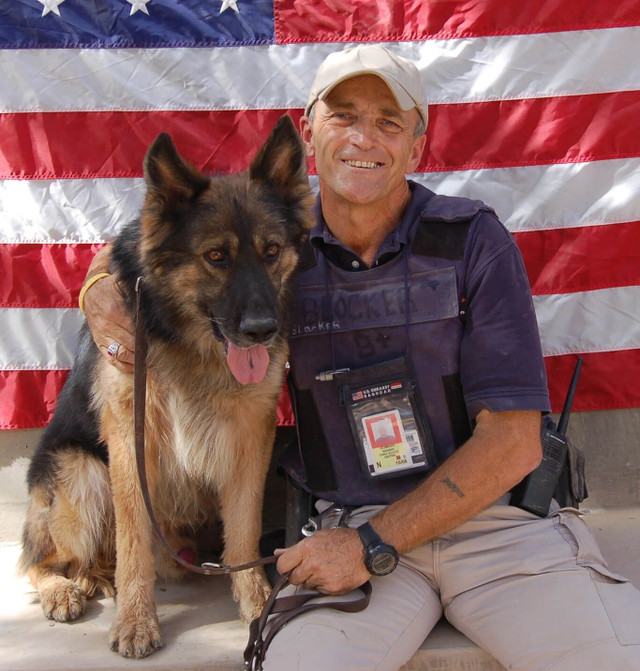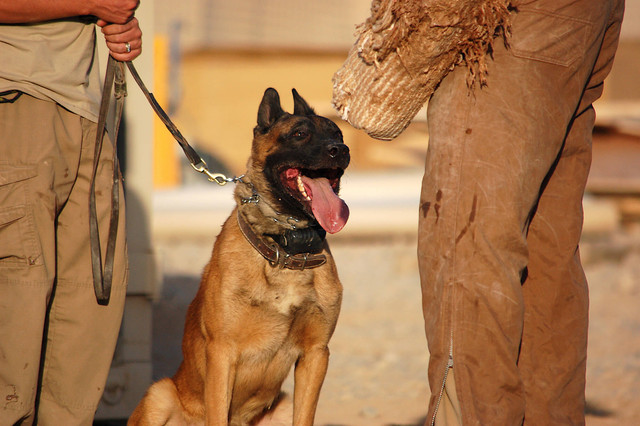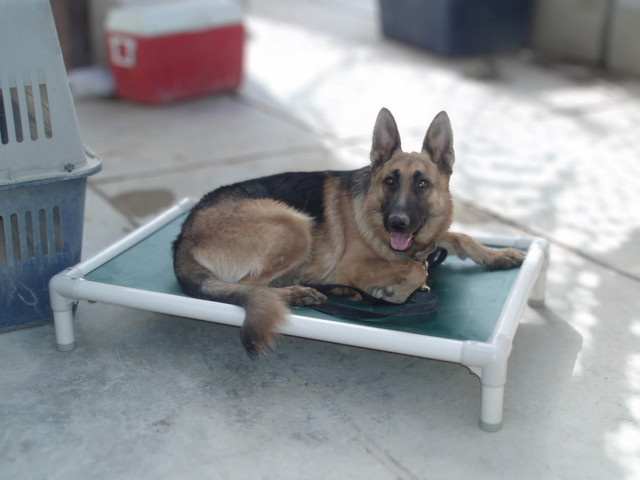
After reading Dennis Blocker’s first book, The Dogs I’ve known in 2 Wars, I was stricken by the risks taken by these brave men, women and their dogs. Think about it, if you have an insurgent wanting to penetrate a check point with explosives or weapons, the first thing you can be sure of is he’ll blow the bomb the moment it’s detected by a dog.

Dennis and his dogs Toris and Laky, were repeatedly tested at their position. One time a car with 3 men in it tried to get through with a stash of weapons, another time they hid a cell phone in a box in the engine compartment, just to see if his team was good enough to find it. This is not to mention the many times rockets hailed down on them from outside the compound. If you weren’t good at your job, there’s a very good chance you’d end up dead.
Through all of this, Dennis built a trust and admiration for his dogs that burns in his heart to this day. Dennis found us at Kuranda through our ShelterBeds donation program. Up until then, all the bomb dogs were left to sleep on the cement floors of their kennels. Once he found us, he was able to secure 85 beds, which was enough bed donations for all the dogs in his unit. He’s still using Kuranda beds at home! We asked him how he was doing lately. Here’s his wonderful response.
“I have three dogs presently. I have (Laky’s) son, my Explosives Dog who was with me for 13 months in Iraq and I have his grandson here as well. Laky Jr is just over 9 years of age, his son, and Laky Sr’s grandson whose name is Poldark is here as well. Poldark and his dad Laky Jr are being trained for explosives detection. They will travel with me during my book signings to demo how war dogs find explosive odors with their nose.
Then I have Elsie. A Pitt Bull we rescued off the streets of San Antonio, she was a walking skeleton back three years ago. Laky Jr is a full blooded German Shepherd, Poldark is half German Shepherd and half Belgian Malinois, the two best Working Dog Breeds in one dog, he’s extremely smart, high ball drive and high hunt for any ball thrown into a woods, thick brush, or field. Yes I’m still training dogs. Basic, mid level, and advanced obedience. I’m also training explosives dogs for clients. Still rolling forward at almost age 73.

Some War Dog Terms and Rules of success:
- First rule. Whoever controls the leash, controls the team. The dog needs to know he works for you, not for him. The Dog has to know that the Trainer or Handler IS the Alpha, however, that he or she is also NOT their enemy. This dogs Handler or Trainer has to learn how to balance this with controlled discipline and love for the Dog! In the end, this dog knows it's loved in conjunction with being disciplined.
- The Dance. This is when the Handler or Trainer and the detection Dog are in perfect sync together, almost as if their brains and nerves have all joined together and the two of you have become "ONE!" It's a PERFECT enjoyable time together, it's what I call, "Dancing together!" Like two professional dancers performing on stage, they each KNOW what their individual moves are, and bringing them together in this performance they become "ONE", they are flowing, "Dancing Together!" It's truly an awesome feeling, even when you're both dancing towards death searching for car bombs. It sounds crazy, BUT, you cannot allow this truth of knowing you may be blown up with the next car being searched, that would affect you and your Dog, shot nerves in a search for explosives is NOT good. Someone may get killed, you have to be cool and calm, and enjoy the DANCE!
- “The Exchange.” This is when a handler throws a Kong (ball) just as his dog releases another kong toward his handler after having retrieved it. “You give me one, and I’ll in turn give you back another.”

- Reading the Doggy News? When the Handler or Trainer takes the Dog out for a potty break you'll notice how the Dog is sniffing the grass, bushes, tree bark, in the K9 world we call this "The Doggie News Paper." Your Dog is reading all of the many various scents left behind by other animals, and you'll see your Dog "Marking" those areas with his or her urine, letting the other Dog or critters know your Dog is leaving behind his or her signature for others to READ.
- How do you check your GSD for hip problems? Place the flat of your right or left hand directly over and on top of the dogs back and hip area. Then have them walk. You’re attempting to discern any bumping or grinding on the palm of your hand.
- Air Scenting. When a dog lifts his/her nose to the air and is smelling different scents that carry in the wind. Especially the scent he/she is trained on.
- Alpha Dog. The one dog that other dogs fear and respect. This dog may challenge a trainer or handler by refusing to perform. This type of dog needs to be taught right away that he's NOT the Alpha, the trainer or handler IS the Alpha, it can NEVER be the opposite. A dog should NEVER be an Alpha over any human!
- COB “Change of Behavior”. How a trained dog behaves when he/she has come into an oder that he/she has been trained to detect.
- Distractors. Anything that might pull canines off their search.
- False sit. When a dog will sit where the odor is not. He/she is trying to fool you into throwing their reward toy to them.
- Going Down the Leash. Your emotions travel down the leash to your dog. If you are angry and distracted your dog will pick up on it and mirror your behavior.
- JND. Just Noticeable Difference. An indication from your dog that it is onto odor. This is something more subtle than “Change of Behavior.” It is something only the handler would notice in their canine.
- Reading Your Canine. You know what your Dog is thinking by learning how to read it's "Body Language, Change of Behaviors." It could be the slight lifting of it's tail, telling you it's coming into an odor, then, the tail comes up faster and is wagging faster, telling you the Dog is getting closer to this odor, or whatever it is which has got his or her attention. It could be a slight tilting of the head, it could be the body jerks ever so slight, it's ears may twitch, or go straight up, it may whine ever so slightly, these are just a few "Changes of Behavior" your Dog, or my Dogs are telling us something NOW has their interest. Once you learn all of these signs in "Body Language" your walks will be much more enjoyable with your Dog(s) because now you can tie it all together as their way of communicating messages to those who CAN read a Dogs "Body Language.
Dennis Blocker's books The Dogs I've Known in 2 Wars: Book One: Iraq and The Dogs I've Known in 2 Wars Book Two: Afghanistan can be found on Amazon.
